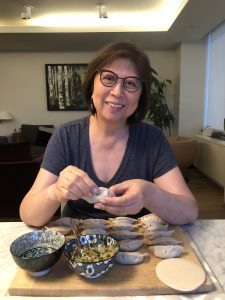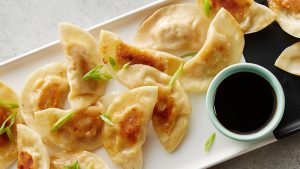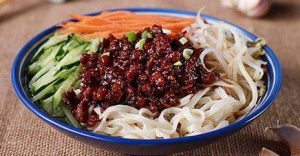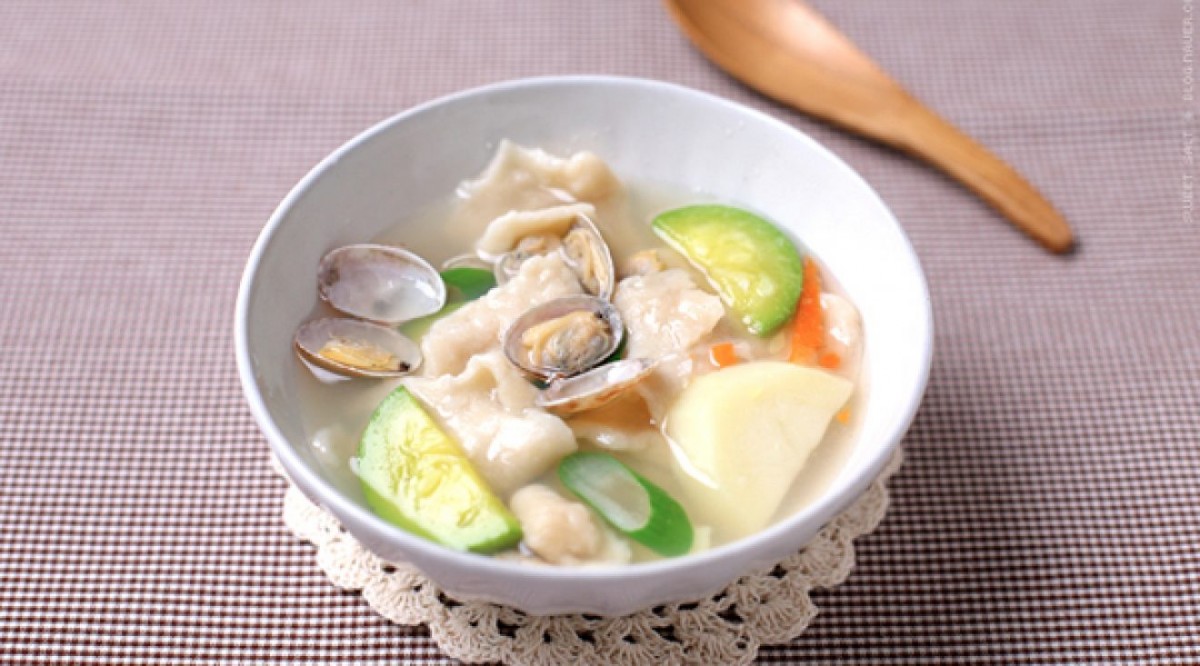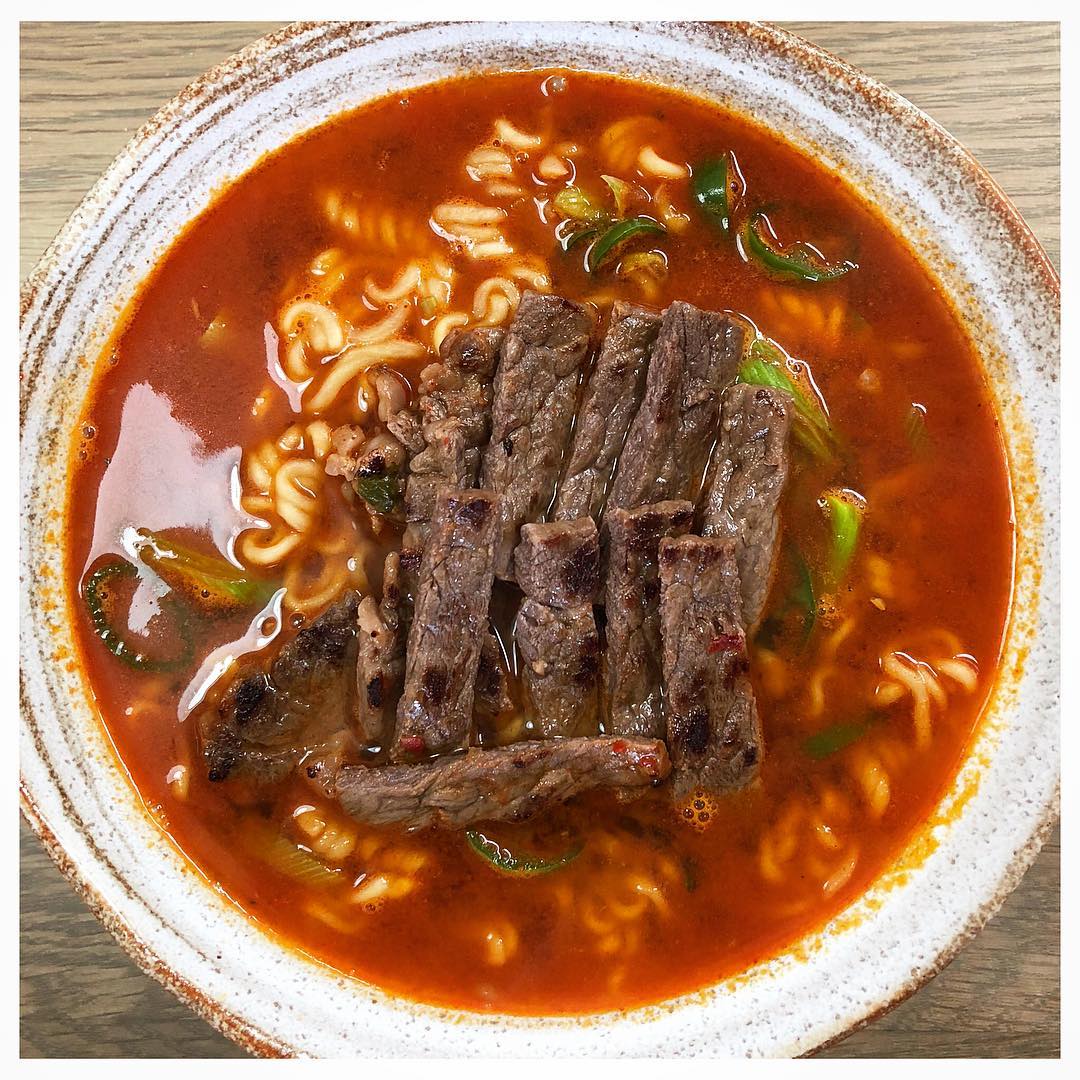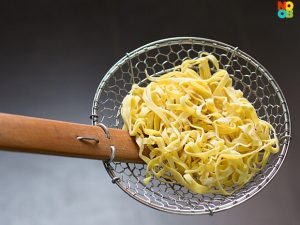Pad See Ew (ผัดซีอิ๊ว) is a Chinese-influenced Thai noodle dish found in street food stalls and restaurants throughout Thailand, and in most every Thai restaurant across the United States. Pad See Ew literally means “soy sauce stir-fried noodles.” It is a wide rice noodle dish mixed with protein, vegetables, and a sweet brown sauce. The base ingredient, fresh extra-wide rice noodles, can be found at Asian grocery stores. The Thai version, sen yai, is what I use in this recipe. If you cannot find sen yai, use fresh Chinese or Vietnamese noodles of the same shape. I find that thinner noodles or dried rice noodles are absolutely dreadful substitutes, as they make each bite less substantial and indubitably throw off the overall mouthfeel texture of the entire dish. Usually, restaurants will offer Pad See Ew with a few variable selections of either beef, chicken, shrimp, pork, or tofu. It is hard to say which variety of Pad See Ew is most popular nowadays, although pork is most traditional. I typically prepare Pad See Ew with chicken, pork, or beef. During warmer months, a lighter chicken or shrimp version works well with the humidity. In wintertime, pork or beef makes this a heartier, more satisfying dish. At any time of year, I enjoy inviting my friends over to my apartment for a meal of Pad See Ew, and it is quite fun to watch their incredulity as I cook up this seemingly complex dish in a matter of minutes. As with any fried rice noodle dish, it is best served fresh and hot off the wok, but leftovers can keep for a day or two.
Place one pound of broad rice noodles at room temperature for a few hours. Pull the noodles apart. Work with caution, as the noodles can rip easily. Prepare 4 or 5 cups of Chinese broccoli, “gai lan”, as follows: wash well, peel the stalk, separate stalk pieces, and slice both the leaves and stalk into 1 ½-inch strips. Peel and mince 4 garlic cloves. Cut your protein-pork, shrimp, or beef-into 1-inch strips. If you are using tofu, chop into 1-inch cubes. Put the wok on a gas burner and turn the heat to medium high. Warm some cooking oil that can tolerate high heat, and then sauté the garlic until fragrant. Add protein to the wok and stir rapidly until the protein is just underdone. Move the protein over to one side of the wok. Add some oil to the other side of the wok, and scramble 2 eggs very quickly just until solid. Reduce heat to medium-low and add the broccoli stalk pieces to the wok. Toss the ingredients for a minute or two until stalks soften. Reduce the heat to low. Add the noodles, Chinese broccoli leaves, a tablespoon of light Thai soy sauce, a tablespoon of sweet dark soy sauce, 2 teaspoons oyster sauce, a teaspoon of sugar, and a teaspoon of white ground pepper to the wok. Stir fry very gently. Pick up the noodles from the bottom of the pan with a spatula and fold them over the top of the ingredients (this prevents the noodles from falling apart) just until sauce is absorbed. Turn up the heat to high and stir fry gently for 30 to 60 seconds (this gives the noodles a crisp char). Taste and adjust seasoning. Serve with chili flakes, sriracha sauce, and cilantro leaves on the side, if desired. Serves 4 as a meal, or 6-8 as a side dish.
1. What piece did you choose to imitate?
I chose to imitate recipes from Under the Tuscan Sun by Frances Mayes. Specifically, I chose to imitate the headnote style from the Winter Bruschetta and Wild Mushroom Lasagna recipes, but I wrote the actual recipe in a style drawn from all her collective recipes.
2, Why did you choose this piece?
I found Mayes’ memoir-style recipes and writing style to be incredibly evocative and engaging. Her smooth conversational style of writing seems somehow both effortless and carefully composed at the same time, and her writing made me feel that I was either listening to a very refined friend of my parents’ speak, while other times evoking the essence of a friend who is sharing cooking tips with me, such as when she admits “I’ve often burned eggplant on the grill” (Mayes 223). I chose to imitate Frances Mayes’ recipe style because I found her tone and style of writing intriguing, in large part because of the way she danced between the role of a privileged, well-traveled connoisseur and the role of friend and confidante.
On the one hand, she is a culinary expert who has more knowledge and wisdom in the kitchen than most, and this is a book that is largely about food and cooking. On the other hand, she was a newcomer in a foreign land, speaking a foreign language, and faced bumps and hurdles as such. She is not afraid to reveal her identity as someone who is new to Italian cooking. She freely admits that the vegetable cardoon and the Italian apples she finds in Tuscany are unfamiliar to her at first (Mayes 230-231). Nevertheless, she is an authority on Italian cooking in the eyes of her mostly non-Italian readers, as she possesses more knowledge than most of those who will read and try her recipes. Perhaps this is why her voice as an author is able to move so well between friend and expert.
I also chose to imitate her because on some level I believe I can relate to her position when it comes to Thai cuisine. On the one hand, as an American-born daughter of a Thai immigrant, I have a certain insight into Thai cuisine that my fellow Americans do not have. On the other hand, if I were to go to Thailand, I would find that my cooking and food knowledge and skills would be very far behind those of Thai natives. So, as a Thai-American person, I might be an authority on Thai food to my American friends (as Mayes was to her primary audience), but when in Thailand I would need to learn and absorb information from those around me from trial and error, as Mayes did in Tuscany.
Although Frances Mayes’ voice is clear in all of her writing, I found that she went into much greater depth in certain recipe headnotes, such as in the Winter Bruschetta and Wild Mushroom Lasagna recipes, using detail and elaboration for the reader’s benefit. For example, in Winter Bruschetta, Mayes writes about items that appear on “every menu in Tuscany” (Mayes 222), which is insightful information on the food culture of Tuscany during the 1990s. I tried to give similarly relevant anthropological information on where one could find the dish “Pad See Ew” in my recipe headnote. In Wild Mushroom Lasagna, Mayes reveals her own ingredient preferences by explaining how prepackaged lasagna “leaves [her] “cold” (223), an exaggerated, dramatic description that imprints her idea in the readers mind. In my recipe headnote, I imitated this style closely by asserting that noodles of the wrong width for the dish are “dreadful” in order to catch the reader’s attention. In reading excerpts from Under the Tuscan Sun, some of the most engaging elements were in the recipe headnotes, so I imitated two headnotes that went into greater detail and revealed more information.
3. What did you learn about the culture of the original author through imitating his or her style?
I learned a good amount about Frances Mayes’ cultural background by imitating her work. In her recipes, she refers to her Southern upbringing. She mentions her Southern heritage directly in her Lemon Cake recipe, and explains that the cake is from her family and is southern. Her decision to bring “Georgia pecans” (Mayes 221) back to Italy gives away her Southern American heritage. In addition, we learn that she is Christian because she mentioned that her family used to have a Christmas turkey every year in the headnote for her Roast Chickens Stuffed with Polenta recipe (Mayes 227). So, we know that she is from the Southern United States and of the Christian faith. By reading her style and tone of writing, it becomes clear that she is both very well-educated and from a privileged upbringing and background. She speaks in a highly educated vernacular, and uses a vast vocabulary. The absence of certain details revealed Mayes’ privilege in some ways. Often, recipe authors might mention cost or the concept of getting good value from a particular ingredient or meal. However, these concepts are entirely absent in the excerpts from Under the Tuscan Sun. Even when her recipes call for ingredients that seem extravagant, she does not touch on the topic of cost. That indicates that cost was not a natural concern for her when cooking, as it is for many other food authors, which we have seen in other food memoirs . She alludes to her privilege overtly in her recipe for Quail, Slowly Braised with Juniper Berries and Pancetta. In this recipe, Frances Mayes mentions her family cook, Willie Bell. The fact that she had a family cook growing up indicates a certain level of affluence. On a larger scale, the entire premise of the book-that she was able to move to another country and purchase a villa-also reveals that she enjoyed a certain level of economic advantage. She uses language that portrays her as someone full of daydream, whimsy, and amused determination. These traits are more often possessed by those who have the means to behave as such. Her cultural perspective works well with her style of book, because her recipes are sumptuous and decadent, meant to be cooked slowly with the Italian virtue of patience for a good meal. These are not quick, street food recipes for hardworking hands that need to stretch every dollar, euro, or yen.
4. What did you learn about your own culture while writing?
I also learned a lot about my own cultural perspective by imitating Frances Mayes’ book, Under the Tuscan Sun. I realized that although I am both Thai and American, when I think of the cultural foods that my heart and soul find to be “home foods”, I think of Thai food. When it came time to decide what type of recipe to use, I knew in an instant that the recipes I would be best equipped to write about were the ones that I saw being made in my kitchen growing up, and the dishes I ate in the Thai restaurants my family frequented whenever we could. Although I have made countless American-style dinners by improvising or following a recipe word-for-word, the techniques and values of those recipes don’t seem as balanced and intuitive as Thai recipes do for me. I realized that my food cultural roots are rooted in Thai and Chinese-influenced Thai food.
On the other hand, I also realized that I do have certain American instincts when it comes to cooking and cuisine. As I read Mayes’ recipes, I realized that there were no notes at the top indicating exactly how long the recipe would take and I almost became alarmed. I instinctively tried to calculate how long a recipe would take. I am entrenched in the American lifestyle of speed, efficiency, and convenience when it comes to food, and my instinct to figure out the amount of time for a recipe indicates that. I saw one recipe that I wanted to make, and when I saw it I wanted to write down the exact ingredient list, each cooking step, and estimate the time required for each cooking step. The Italian virtue of patience (as mentioned in “Art of the Feast” on BBC) with cooking is something that I admire and aspire to, but it is clear I will need to practice that patience if I am to fully embrace the slow, careful Italian style of cooking. It does not come as naturally to me as I might like. As I wrote my recipe in the style of Mayes, I found the task difficult at first because I am used to reading and writing recipes with a clear ingredient list and numbered cooking steps, which is very American and geared toward speed. However, by the end of the Pad See Ew recipe, I rather enjoyed writing my recipe in this new style. This style of writing, which took time and care, really made me appreciate the most important techniques and the flow of the recipe because I was focused on the instructions rather than dividing everything into logical steps.
5. Is there cultural DNA embedded in the piece you read and in your piece? How does this DNA manifest in the texts?
Frances Mayes’ Under the Tuscan Sun revealed the history and cultural DNA of Italy in many of her recipes. Specifically, her work reveals Italy’s cultural DNA in relation to food. For example, she alludes to the Italian value of eating with loved ones in the Winter Bruschette recipe, when she says, “when friends stop in, we open a hefty vino nobile” (Mayes 222). The idea of friends coming to her home to share food is very Italian. Drinking wine with a meal as she mentions is also an important part of Italian culture. Mayes’ focus on Tuscan cuisine reveals an important part of Italy’s history and DNA. Due to the way that various regions of Italy were conquered and invaded, each region of Italy has its own signature style of cuisine. By including recipes from Tuscany’s signature cooking style rather than recipes from other regions such as Sicily or Naples, Mayes illustrates Italy’s history of regional cooking styles, which is a key part of its DNA. The regional cooking tradition is also is closely linked with Italian culture’s regional pride and identity that goes back thousands of years.
Mayes certainly practices the Tuscan way of using seasonal fruit and vegetables, cured meats, and drinking wine in her recipes and stories. Those practices are key elements of Tuscany’s history and culture, and therefore its cultural DNA. Mayes mentions using new ingredients that she finds locally, such as cardoons and a specific type of disfigured apple. It seems that all of the ingredients she uses in her recipes are ones that can be found growing and living locally in Italy. The idea of living off the land and eating foods that are fresh and in season is also a big part of Italy’s cultural identity in general, in addition to in Tuscany specifically. This is connected to Italian culture because historically, Italians would farm, harvest, and eat foods that came almost exclusively from Italy’s land and sea. Regions of Italy consume different types of food based on what grows on the local land. Italians in the north eat pasta with egg because of the soft wheat, whereas Italians in the south eat pasta made without egg because of the nature of their harder local wheat.
My piece of writing has some cultural DNA embedded within in, but it as not as significant or as easily spotted as in Frances Mayes’ work. At the beginning of my recipe headnote, I mention the street food stalls in Thailand. This is a nod to the fact that I have been to Thailand, and may have more than a fleeting connection with the country. The street food stalls are a reference to the street food culture that is popular in many Asian countries, Thailand included. In addition, my recipe calls for specific Asian ingredients that can only be found in Asia or at an Asian grocery, so it reveals that my cultural environment, is one that includes access to Asian grocery stores. Overall, there is not as much cultural DNA in my writing, in comparison to Under the Tuscan Sun.
Francis Mayes’ Under the Tuscan Sun served as a wonderful inspiration for writing my own recipe in her style of patient, high-quality Italian cooking in the Tuscan tradition. Her writing brought Italian cuisine and cultural concepts to life. Writing like her made me question my own cultural food identity, and how my background influences the way that I approach cooking food, and food in general.


